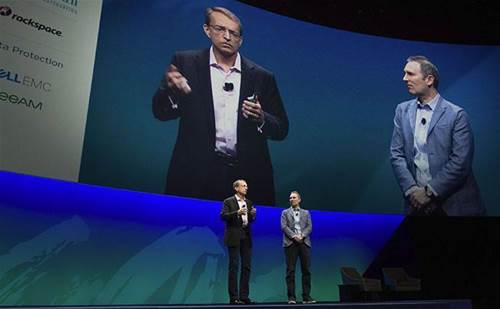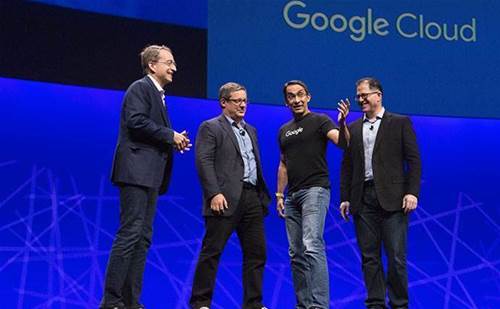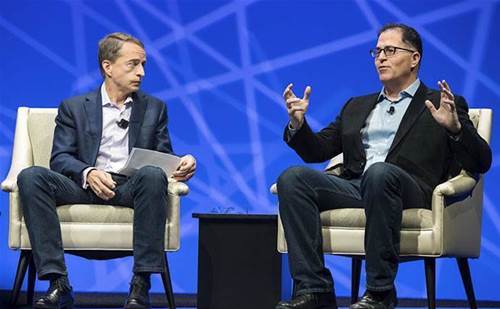Being vendor-independent has always been central to the VMware model. This meant playing nice with server makers like Hewlett-Packard, Dell and IBM throughout the glory days of the virtualisation blitz. Now as mature IT markets like Australia reach peak virtualisation, VMware is betting on a new set of vendor alliances to grow its business in a multi-cloud, multi-device world.
These partnerships were on display at VMworld 2017 in Las Vegas. They offer an insight into where VMware sees its business in the future, and where VMware partners should align to stay relevant to the vendor's strategy.
Amazon Web Services
VMware Cloud on AWS was the biggest talking point of the conference, with AWS chief executive Andy Jassy joining VMware chief executive Pat Gelsinger on stage for the opening keynote. It's a marked change from one-time rivals, with Gelsinger telling CRN USA that "obviously we didn't start out with the greatest relationship between Amazon and VMware, so there was a bit of trepidation on both sides".
"Are you going to deliver or not, Andy? So there was some relationship-building to be done there, and I would just say they've been a great partner."
VMware Cloud on AWS will allow enterprise customers a way to fast track their public cloud migration without being required to rearchitect their legacy applications, which is perhaps the biggest limiting factor holding back greater cloud adoption.
For applications already virtualised on a VMware vSphere environment, it is a simply a lift-and-shift to migrate them to the same vSphere environment running on AWS bare-metal infrastructure (with one caveat – they must be running the latest version, vSphere 6.5).
After that, enterprises should be able to capitalise on the benefits of public cloud, such as greater elasticity, availability and resilience, along with easier integration with AWS' enormous ecosystem of cloud-native applications.
In an interview with CRN Australia, Gelsinger expanded on the million-dollar question: when will VMware Cloud on AWS land down under?
"We don't have a specific plan for that yet. Clearly when you look at Asia, where do you put it first – Australia, Singapore or Japan? Australia, I think, is still the most virtualised country in the world," he added. "We will pick between one of those as number one. Number one will happen fairly early in the year."
Gelsinger confirmed that VMware plans to go live in every AWS availability zone (AZ) by the end of 2018. "Getting the first one up – that's done. Getting the second one up means we have a fair amount of engineering with multi-AZ, cross-AZ and some of the DR aspects. So we have to get that done. Once that is done it is just a matter of the geographic enabling that we have in place."

Day two of VMware saw another one-time cloud foe take the stage with VMware. Sam Ramji, VP of product management, developer platforms at Google Cloud, joined with Gelsinger, Michael Dell and Rob Mee, chief executive of Dell EMC company Pivotal, to unveil Pivotal Container Service.
The partnership between Google, VMware and Pivotal aims to help enterprises bring container-based architecture to VMware operating environments. The partnership centres on a commercial release of Google's Kubernetes container platform (in fact, Pivotal Container Service is initialised as PKS, as a reference to Kubernetes).
Like the AWS partnership, the Google and Pivotal alliance will offer enterprise customers another way to move their applications to the cloud.
Michael Dell outlined the issue for enterprise CIOs. "All our customers are facing similar challenges. They have their production apps and they want to get more value from those. But there is this urgency of digital transformation and, 'How do I very quickly enable my business?'"
"Companies need to run thousands of legacy applications. They need to build new cloud native applications to take their business into the future. And they want to do all of this without sacrificing availability or security and they want to reduce cost at the same time," said Pivotal's Mee.
"PKS is always going to contain the latest stable release of Kubernetes, keeping consistent compatibility with Google Cloud Engine," said Mee. "It's engineered to be incredibly efficient to operate. It's got NSX built in, so it has a strong emphasis on application security. It comes out of the box with integration with the Google Cloud Platform services."
In advance of VMworld, Google also announced that VMware's unified endpoint management solution Workspace One would enable management of all Chrome devices from a single console.

IBM
Most will be aware of VMware's decision to throw in the towel on public cloud with the sale of vCloud Air to French-headquartered hosting company OVH. The other facet to that decision was VMware's earlier partnership with IBM to make it easier to run VMware environments on the IBM cloud, formerly known as SoftLayer.
VMware's software-defined data centre (SDDC) environment, which comprises vSphere for server virtualisation, NSX for network virtualisation, and VSAN for storage, can be automatically provisioned on the IBM cloud.
Given that VMware's cloud partnership with IBM was announced last year, the cloud partnership with Big Blue didn't get the same VMworld stage time as AWS or Google. But security did.
Senior VP of IBM Security, Marc Van Zadelhoff, joined Gelsinger on stage to discuss AppDefense, a new solution to embed security at the hypervisor layer.
"Many of the geekiest people in my security team are excited about AppDefense. It reduces the attack surface immensely," Van Zadelhoff said.
He revealed that IBM and VMware were "collaborating on an application that will bridge between AppDefense and our security operations and analytics technologies – QRadar, Watson for Cyber, and our resilient orchestration technology".
"This application, which will be done by the end of the year, will take all the information, all that visibility that AppDefense now provides and will bring it into the security operation centre and combine it with everything we know about the rest of the environment. It will give context, it will give more analysis and it will give action," Van Zadelhoff added.
It's clear that VMware is hell-bent on strengthening its ties with all major public cloud providers (with the exception of arch-rival Microsoft). IBM and AWS were both global diamond sponsors of VMworld 2017 and Google Cloud was a silver sponsor.

HP
Another third-party vendor to appear on stage at VMworld – by video anyway – was HP Inc. The PC and print vendor's Australian-born chief executive, Dion Weisler, revealed that HP was embedding VMware Workspace One in its device-as-a-service platform. It followed a similar partnership around Dell client devices announced at Dell EMC World 2017.
Workspace One can now manage mixed fleets of essentially every operating system, including Windows PCs, Macs and Chromebooks as well as Apple and Android mobile mobile devices. It is based on technology from mobile device management vendor Airwatch, which VMware acquired in 2014.
"HP and VMware are long-time partners. Today I am excited to announce an even deeper extension of our collaboration. During your event, we are announcing that VMware's unified endpoint management solution will be incorporated into HP device-as-a-service offering," Weisler said.
"VMware's endpoint management solution will be a key component of our managed service offering, enabling customers to use real-time actionable insights and world-class security monitoring."
HP device-as-a-service offers customers a single contact and single contract for commercial devices and services, allowing customers to pay on a monthly per-device basis, and VMware's Workspace One will allow HP service agents to more easily manage fleets of devices.
Dell EMC
It might seem odd to talk about a deeper partnership between Dell EMC and VMware, given that the former owns the latter. But VMware has been very deliberate about maintaining its independence from Dell EMC, important given VMware's ties to the rest of the hardware vendor community.
Pat Gelsinger reiterated this in an interview with CRN USA. "It just can't be that we're shoving to Dell, that Dell picks up business that other partners might have gotten otherwise. Other partners would do something else other than work with us in the future, so this requires a lot of discipline. Our programs need to be well in place… and Dell needs to discipline their sellers very well because they can't go strong-arming partners.
That said, there are clear benefits to VMware of the new ownership. As a channel to market for VMware, Dell is "showing up", Gelsinger said.
When forecasting the benefits in the lead-up to the Dell EMC merger, "we were out to get a billion dollars of synergies on a per-year basis over and above the starting line", Gelsinger said.
"On our Q1 earnings call, of that billion, I updated that number from US$200m to US$250m. We are running ahead of schedule on our piece of that.
"What does that mean? It means Dell is selling US$250 million more of our 'stuff' in one way or another this year. Over a several-year period that gets to be in excess of a billion dollars.
"So from my perspective, Dell is showing up and selling more of my stuff. That could be putting vSphere on a compute server. They are selling more VSAN and VxRail. They are bundling more NSX into their solution sell. We are seeing all of those."

Ross Brown, VMware's senior vice-president worldwide alliances, agreed, telling CRN Australia that VMware has "done some work to make it easier for us to be coordinated with the Dell team in front of partners and customers".
"By the way, we will do the same thing with HP or anyone else if they want to make the same level of investment that Dell has done. Dell has leaned in on our business incredibly hard, even though the financial stuff is still separate and there is an arms-length relationship. It is not that we have a favouritism towards them, we have a favouritism to anyone who invests to the level they are investing – feel free to step up."
The journalist travelled to VMworld as a guest of VMware







_(11).jpg&h=142&w=230&c=1&s=1)


.jpg&w=100&c=1&s=0)
_(8).jpg&w=100&c=1&s=0)







.jpg&q=95&h=298&w=480&c=1&s=1)





